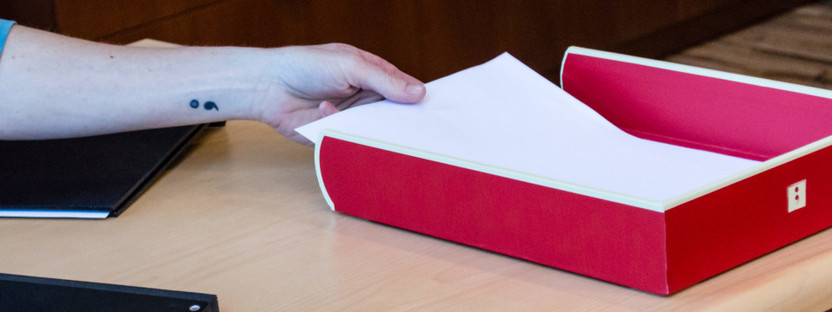Designing a Desktop Paper-Flow System
Posted by Julie Morgenstern on Feb 17th 2017
Nothing is more intimidating and demoralizing than walking into a desk covered with papers, and not knowing where to start. It leads to procrastination and much time wasted repeatedly sorting through miscellaneous piles, just trying to figure out what needs to be done. Most studies say the average worker loses 1 hour per day searching for missing information in messy desks and piles.
The most effective method of taming desktop paper clutter is creating a transient paper system (also known as a paper-flow system) in conjunction with your filing system. This will help you to process the papers you receive on a regular basis.
Transient papers are items in process. A concrete system will give a home to papers that cross your desk which need you to take an action on before passing them along to someone else, file, or toss. Once you have taken an action on them, you either send them out or file them in your permanent files.
Here’s how to create a transient file system:
Sort
Sort the piles on your desk into categories by specific action. Common categories: Reimbursements to Submit, Calls to Make, Documents to approve, Materials to Read, Items to Discuss with Boss (or assistant/direct report/colleague), Items to File.
Store
If your job is basically desk based, select attractive stacking paper trays, one per action item. If you have 6-8 categories, get 6-8 trays. You can place these on your desk, a side table, or credenza behind you to keep them accessible and keep your desk surface clear. Choose a style that matches your aesthetics: either desk organizers or traditional, elegant wooden trays.
Transport
If you need your transient system to be portable, choose something you can carry with you. Accordion expanding wallets fit nicely in a briefcase or tote and look very professional in a meeting! Some of my favorite options are from the Designer File Management line, which creates an upscale organization system that travels well.
As papers come in, simply place them into their appropriate bin or pocket. Having your work subdivided into visual categories allows you to see at a glance what work needs to be done and helps you tackle it one category at a time. It creates quick order out of chaos, allowing you to focus on doing your work, rather than avoiding it. This strategy alone has saved many clients 1-3 hours of productivity per day.
Written by Julie Morgenstern
For over 25 years, New York Times bestselling author and organizational consultant Julie Morgenstern has transformed the way individuals and companies function around the globe, including American Express, Microsoft, FedEx, and the NYC Mayor’s Office.
Her cutting edge advice has been featured on programs from The Oprah Winfrey Show to Good Morning America and NPR, and she is regularly featured in a variety of print magazines and publications, including Forbes, Harvard Business review, and The Wall Street Journal.
In today’s fast-paced culture, professional success often seems synonymous with long days, never-ending to-do lists, and sleepless nights. But it doesn’t have to be that way.

